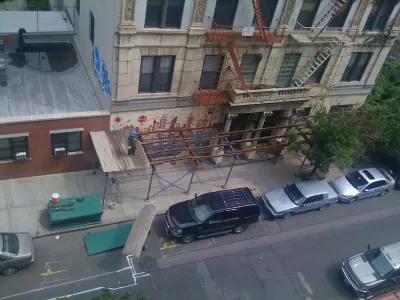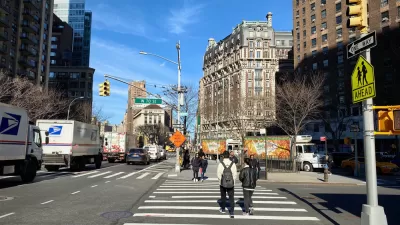A 1980 law protecting pedestrians from falling debris has spawned a labyrinth of sidewalk sheds: the covered walkways that often support scaffolding. Many of these "temporary" structures linger for years.

Construction and repair work brings with it a collection of temporary structures. Too often, those sheds, scaffolds, barriers, and portable toilets can become semi-permanent fixtures that mar the beauty of a street or facade for years on end. Aaron Elstein documents one such case: the New York City sidewalk shed.
A 1980 law requires building owners to protect pedestrians from falling masonry, but good intentions have led to unexpected side effects. Elstein writes, "[Landlord Muhammad] Shahid may infuriate people who live near his property, but he's one of many landlords who have concluded it's cheaper to keep up a shed—and pay fines for violations—than it is to fix a building."
The maze of sheds girdling the city's walkways are an unsightly nuisance to residents and business owners. From the article: "The chief purpose of this particular shed, on a handsome block in the Mount Morris Park Historic District, seems to be to collect garbage and provide shelter to the loiterers who lurk underneath. Repairs at the building it surrounds move at a glacial pace."
The scale of New York's shed problem is troubling given its status as the nation's most walkable metropolis. "There are now nearly 9,000 sheds entombing city streets, according to the Department of Buildings, up from about 3,500 in 2003. That's 190 miles worth of sheds, or 1 million linear feet."
FULL STORY: The law that created the billion-dollar scaffold industry has turned city sidewalks into an obstacle course

Rethinking Redlining
For decades we have blamed 100-year-old maps for the patterns of spatial racial inequity that persist in American cities today. An esteemed researcher says: we’ve got it all wrong.

Planetizen Federal Action Tracker
A weekly monitor of how Trump’s orders and actions are impacting planners and planning in America.

Walmart Announces Nationwide EV Charging Network
The company plans to install electric car chargers at most of its stores by 2030.

New State Study Suggests Homelessness Far Undercounted in New Mexico
An analysis of hospital visit records provided a more accurate count than the annual point-in-time count used by most agencies.

Michigan Bills Would Stiffen Penalties for Deadly Crashes
Proposed state legislation would close a ‘legal gap’ that lets drivers who kill get away with few repercussions.

Report: Bus Ridership Back to 86 Percent of Pre-Covid Levels
Transit ridership around the country was up by 85 percent in all modes in 2024.
Urban Design for Planners 1: Software Tools
This six-course series explores essential urban design concepts using open source software and equips planners with the tools they need to participate fully in the urban design process.
Planning for Universal Design
Learn the tools for implementing Universal Design in planning regulations.
City of Moorpark
City of Tustin
City of Camden Redevelopment Agency
City of Astoria
Transportation Research & Education Center (TREC) at Portland State University
Regional Transportation Commission of Southern Nevada
Toledo-Lucas County Plan Commissions




























